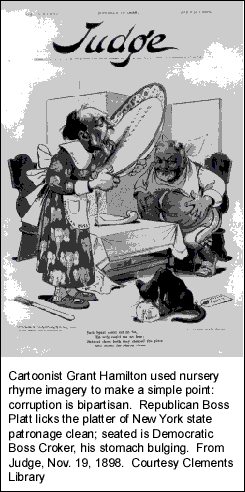The University Record, November 2, 1998
Political cartoons: The picture tells the story
By Joanne Nesbit
News and Information Services
 Political cartoonists have been having a heyday since the Reformation when Martin Luther’s satirical woodcuts were produced.
Political cartoonists have been having a heyday since the Reformation when Martin Luther’s satirical woodcuts were produced.
Cartoons are designed for popular consumption in the cheapest format, “the perfect device for criticism,” says Arlene Shy, historian and archivist at the Clements Library.
“The cartoonist does not have to justify his point of view. He can use his art to report, accuse, entertain, moralize, or to focus public opinion on any target he chooses. His only obligation is to use his art to express an idea, and to make that idea accessible and engaging to the broadest audience.”
Cartoonists have traditionally exposed abuses of power, the corruption of government and the hypocrisy of society. Cartoons provide a running commentary on events, people, attitudes and preoccupations, and reflect momentary shifts in public sentiment.
Although the idea of exaggerating a human form for comic effect began in late 16th-century Italy, printed caricature as a form of political and social commentary was brought to its finest in 18th-century England, according to Shy. Cartoons were sold as separate sheets in print shops and circulated in coffeehouses. Unlike newspapers and periodicals, they were not subject to censorship or libel laws. And one did not need to be able to read to get the message.
Americans took full advantage of this genre and imitated it with great expertise.
The Clements has an outstanding collection of cartoons relating to the American Revolution by English artists, a fine group of original Thomas Nast drawings, and a large number of Jacksonian- and Civil War-era cartoons.
The holdings range from rare Colonial imprints to 19th-century pulp magazines, from fine engravings on single sheets to lithographs mass produced for the popular market. There also are woodcuts, the staple of weekly, illustrated newspapers, and some original drawings, all covering nearly 175 years of American caricature from the 1760s to the 1930s.
You can always drop us a line: [email protected].

